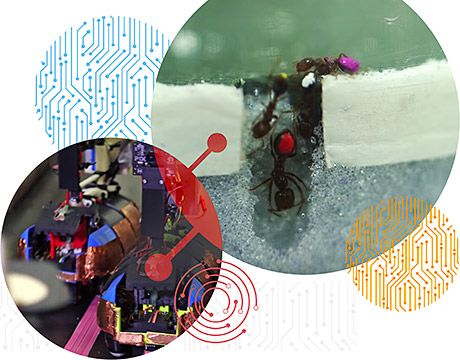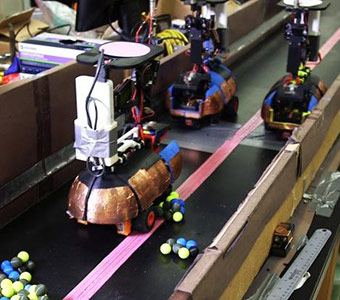"We wanted to know what they do when they're digging,how they decide how to dig if there's no central leader,"Goldman said.7 J4 ^: u) U% R
Goldman說“我們想知道當他們在挖掘的時候做了什么,當沒有中央領導人的時候他們是怎么決定怎樣挖掘的”。
, a3 X$ Q9 R/ p. w/ x+ FFor You:Racism Runs Deep,Even Against Robots
4 h* s J- z$ N" ]: S對你而言:種族注意深入人心,甚至對機器人 Q) Z4 g9 A1 w# `4 w. m
To find out,the team get 30 fire ants,put dots of different colors on their abdomens,placed them in a container of wet glass particles,and watched them dig.The team present its results in a recent issue of Science.
+ a, c( x t% G' B( G& [為了找出答案,這個團隊捉了30只火蟻, 在他們的腹部畫上不同顏色的點,把它們放在有著濕玻璃顆粒的容器中,觀察他們挖掘。這個小組它研究結果刊登在最近的《科學》的問題中。
6 M/ m0 v! r9 i/ v( UThe ants didn't play tag team,work in alternating groups,or take turns in any other fashion.In fact,their strategy is quite simple:A handful of the ants did the work (about 30 percent)while the majority did nothing.
' ^0 i$ D9 b8 D- [. b. T8 F9 \螞蟻沒有玩標簽團隊,工作在可交替的組中,以任何其他方式輪流。實際上,它們的策略相當簡單:少數螞蟻工作(大約百分之三十)然而多數螞蟻什么也不做。0 A* K6 i7 t3 C) n4 r( ?% B& g
"Very few were doing any of the labor,"Goldman said."Over 48 hours,with a group of thirty ants,half never came to the tunnel.") j) ?) s( R3 l2 }2 a0 d: \. L5 t
“很少的螞蟻做任何工作”,Goldman說“超過48小時,一個30只螞蟻的團隊,半數沒有進隧道。”$ F( A a; }) S q
When his team remove the five hardest working ants,five more stepped up to the plate to carry on the digging.
7 _2 d. f4 n9 B" j/ J9 k當他的團隊移走了五個工作最努力的螞蟻,另外五只螞蟻爬到了平臺上繼續(xù)挖掘。( z7 H: r4 e2 t# C9 Z+ Y) b
The strategy of minority servitude served the ants so well that Goldman decided to try it on a group of robots.1 X& Y& m$ r4 g
少數奴役的策略為螞蟻很好的服務,于是Goldman決定在一組機器人上嘗試這個。# p4 r* _+ h% B) W5 Y% z. h5 N% H
The robots,essentially oblong shells on wheels,resembled armadillos more than ants.Researchers placed them in a narrow channel with plastic valls on
( u+ r* B w$ q; d1 N3 Eone end that served as the soil.The robots would roll over to the balls with the intention of grabbing them,moving them,and relasing them with their. J; B3 g8 M B4 f7 ^: W
gator-like jaws.Push switches on their shells would alert them to the presense of their fellow workers.3 O% }3 S' q6 ~2 ^4 z8 z/ L: [2 a
這些機器人,事實上是輪子上帶有橢圓形的殼,類似犰狳而非螞蟻。研究者們吧它們放在一個狹窄的渠道里,渠道的一端是作為土壤的塑料球。機器人! ] `, k) y& k9 r
將翻滾到到球上,通過使用鱷魚般的下巴有意的抓取他們,移動他們,釋放他們。打開它們殼上的開關將提醒他們同時的存在。
o/ N# M1 v1 B% H: hResearchers programmed the bots to follow one of the three strategies for removing the balls:"eager,""reversal,"and"lazy."
7 A' ]! Y2 p0 D- L研究者們給機器人編程遵循三個策略的其中之一去移走球:“急忙,”“翻轉,”和“懶惰。” {& _$ @* P( ?5 B
Eager robots simply tried go to the dig site as much as possible without interference from their comrades,regardless of how many . B2 w+ i4 f2 e: l8 D* {: P- G
robots were already there.The strategy generated a traffic jams."when we applied a eager strategy,the robots would grind against
9 W1 ^% {1 ^' \# G" V" {1 M+ Feach other and suffer a lot of breakage,"Goldman said.
. a2 A& s3 f! h* k% N3 C急忙的機器人不管來自同伴的干擾而只是嘗試去盡可能的挖掘地皮,不管已經有多少機器人在那兒了。這個策略形成了一次交通擁堵。
, B) V5 |3 T4 Y, L- P7 D! bGoldman說:"當我們應用急忙策略時,機器人會相互反制并且受到了很多破壞。"
: `; \5 e$ O; _8 v6 E7 o% @Reversal robots would turn around and leave the site if they encountered other workers,but would soon return to try again.Lazy robots
`8 r/ |3 K$ Z2 \' b0 c2 Dwere largely inactive and would only head to the site to dig occasionly.
! Y( T5 h( ~1 F! N% J0 c如果他們遇到了其他工作者的話,翻轉機器人將會回轉并且離開地皮,但是不久會返回再次嘗試。懶惰的機器人大部分不活躍,只會偶爾去挖掘地皮。; @+ Q! G$ f" m2 n
When reversal-minded robots approached the balls and found another robot already at work they would turn around.This proved- b: Q: i# H2 {& I {9 Q6 b' W
a relatively efficient scheme with no gridlock,but the work processed slowly.The lazy,ant-imitating robots,however,proved to be the 2 v+ j' ~" X( a
fastest at completing the task.
3 a: c; n4 s2 T當有翻轉思想的機器人接近球并且發(fā)現已經有另一個機器人在工作時,他們將回轉。這種做法被證明是一種沒有堵塞的相當有效的方案,& j+ b- }4 z* g, c
但是工作進程慢。那些懶的,模仿螞蟻的機器人,然而,被證明完成工作是最快的。
0 ]5 l l5 r$ B9 s3 I- S; ZThe strategy could be essential for tommorow's hordes of rescue bots."Future swarm of robots that are moving through a complex
4 d1 Q! \" U/ @+ F" `environment after a nuture disaster,or when a building has collapsed,will be getting in each other's way,"Goldman said."This is a story $ z+ D: ^# K+ F* K {' z+ [
about how to work with uncertainly and unpredictability."- K2 {+ G4 V) \: t: u4 ` L. Q8 @
這種策略會對將來的成群的救援機器人有效。“未來在的一群機器人穿越一場自然災害過后的復雜的環(huán)境,或者當一棟倒塌后的大樓,將會
) Q0 [& e! c w, r6 z5 X, U' Q互相幫助,”Goldman說。“這是一個關于怎樣處理不確定性和無法預料性的故事。”% Z# ~: N( W* Z$ h
In the story,robots that talk with each other could take turns or replace robots that lose power or wear out."But then you have to know
$ Q$ A( e P( n+ V1 I4 `what everyone else is doing,"Goldman said.This woud require the technology and programming for higher levers of communication.(As it* w3 V" m( X- Q' |! p
happens,no one knows how ant chose which 30 percent does the work.)But having "lazy",autonomous robot,could keep things lean and
- W* |0 Z5 Z* I' o8 befficient.
; P1 l% \9 M' ^& F) A1 B6 x6 f* S在這個故事中,機器人可以互相交流能回轉或者替代沒有電或者電力不足的機器人。“但是你必須知道所有其他人在干什么,”Goldman說。
6 u8 o4 q! M0 o% X2 A" l這樣就需要技術和編程更高等級的交流。(當它發(fā)生的時候,沒人知道螞蟻是怎樣選擇哪30個做這個工作。)但是有了“懶的”,自主性機器人,$ ~# P7 o K- q2 y6 b0 |* H: b. ~
可以保持精益和高效。
4 X, o4 N( X. V" Z0 |- s0 q) r$ h. O5 g6 A* z0 `& S
& q/ J3 t0 W4 L C
Michael Abrams is an independent writer
- d, u. Y% I) r7 j+ m. L摘自:https://www.asme.org/engineering ... e-ants-get-job-done+ ~ x* _% O) t! A' S! n( Z% r2 z0 y
|
|
|
 : q$ J0 o5 ~: ]9 a
: q$ J0 o5 ~: ]9 a